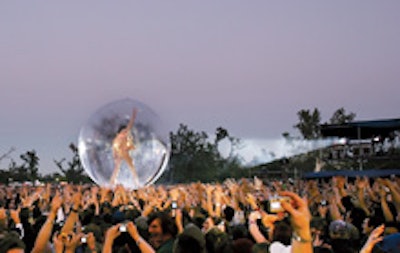
Big egos, bigger storms, and the occasional impromptu jam session—the people who coordinate the biggest music festivals have seen it all. Here’s what they do to keep everything harmonious.
Look for unexpected combinations.
“Some things are exciting because of the chances you take, like pairing a great American guitarist such as Derek Trucks with a master musician from India like Pandit Debashish Bhattacharya to explore the commonalities of Southern blues and classical Indian ragas,” says Rob Gibson, executive and artistic director of the Savannah Music Festival. “These types of musical experiences push both the artists and audience. When successful, they create a powerful bond.”
Project grace under pressure.
“This year, Saturday night headliner the White Stripes canceled the week of the show due to a medical emergency, and Friday morning we had a water-main break that turned our pecan-grove V.I.P. area into a river,” says Autumn Rich, special events planner for the Austin City Limits festival. “The whole world was watching; there was an enormous amount of media. When you plan an event of this size, always appear calm, no matter what happens. Patrons just want to see calmness and togetherness—everyone follows your lead. No matter what’s happening, if I need to have a moment, I go off on my own. It’s not in the public eye.”
Invite spontaneity.
“This past year, John Mayer was headlining the amphitheater, and the day he was slated to play, he found out that Buddy Guy was performing, too,” says John Bowler, vice president of sales and marketing for Summerfest in Milwaukee. “He said, ‘I want to go jam with him.’ So after his performance, I took him to the stage where Buddy Guy was playing, and he and John Mayer had this impromptu 45-minute blues jam. The crowd loved it.”
Don’t be afraid of wild ideas.
“We received an email from a very nice couple who explained that they really, really wanted to have their wedding at the festival,” says Dan Shaw, event director for the 10,000 Lakes Festival in Detroit Lakes, Minnesota. “Wary, but thinking it might be fun, we scheduled it at noon on one of our nicest music stages, complete with band, wedding party, minister, ushers, and 300 groggy festival attendees who accepted the open invitation. The ceremony was a blast, followed by a loud and obnoxious wedding parade back to the campgrounds for the reception. My favorite memory is of one of the fine local police officers doing the chicken dance in a ring of tie-dyed folks eating cake and cheering him on. The lesson learned is that people love free cake, and that sometimes ideas might seem silly at first, but end up being brilliant.”
Don’t underestimate willpower.
“Fifty-nine days out, the levees broke,” says Stephen Rehage, founder and producer of the New Orleans-based Voodoo Music Experience. “Putting on the 2005 event was sheer will, and it was the hardest thing I’ve ever done in my life. There were no hotel rooms at the time, so all the artists made the commitment to come in on tour buses and stay there. We had to bring in 100 percent of the equipment and drive it down from Memphis. It was literally a 24-hour-a-day job. When we were in the middle of building the stage, FEMA confiscated our cranes for an emergency and didn’t give them back for six hours. Fortunately, I had a big ally in Trent Reznor—he was the one artist who said, ‘I’m going down there even if I have to bring my sleeping bag.’ He and all of Nine Inch Nails showed up early and helped us build the dressing rooms. There was no separation between artists and production crew.”
Have backup plans.
“In 2006, on our opening Thursday, the power to the facility went off at 3 p.m., just as people were pouring in and we were about to have our opening ceremonies,” says John Bowler of Milwaukee’s Summerfest. “We had about three hours and 15 minutes of no power. There were a couple of PA systems on a backup generator, so we were able to keep everyone abreast of what happened. When people realized it might be a while, some of the artists came into the bleachers with acoustic guitars to jam with the crowd. We also had the University of Wisconsin marching band on the property, so they fired up their routine to entertain the audience.”
Solicit input for improvement.
“Feedback and more feedback from your patrons is key,” says the 10,000 Lakes Festival’s Dan Shaw. “We give as many opportunities as possible for comments, criticism, and suggestions. On-site surveys, comment cards, email, online polls, and forums all provide invaluable information about the patron experience. Offering giveaways or a contest for submitting the questionnaire has also helped increase the number of people who respond. The best improvements have come directly from suggestions from the audience.”
Know how to reach your audience.
“The first year, 1999, we went with an online service and thought we’d sell all our tickets online,” says the Voodoo Music Experience’s Stephen Rehage. “The thing is, people were still using 56K modems and couldn’t complete the transactions on the Web, so that led to everybody walking up to buy tickets. Then we hit a thunderstorm, and our walkup traffic dropped off. It was a hard financial lesson to learn.” A switch to a more standard ticketing system, plus good first-year buzz, helped spike ticket sales from 8,000 to 65,000 the following year.



















